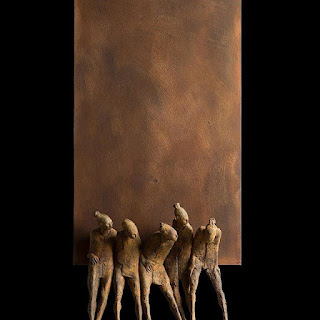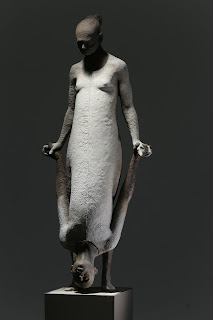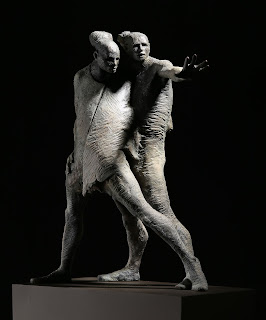ARTISTAS DEL MUNDO - GUATEMALA
ARTISTAS DEL MUNDO - GUATEMALA
Hoy viajamos a Guatemala a conocer el escultor Max Leiva, los invitamos a disfrutar su historia y su arte.
Nació en Guatemala el 17 de enero 1966. Fue con su padre con quien tuvo al alcance el yeso del laboratorio dental, y desde muy joven aprendió a moldear prótesis dentales y figurillas de yeso y cera. Cursó tres años en la Escuela Nacional de Artes Plásticas Rafael Rodríguez Padilla, entre 1972 y 1975. En 1988, se inscribió en la Escuela Nacional de Artes Plásticas donde recibió clases con Víctor Vásquez Késtler, Ernesto Boesche, Dagoberto Vásquez, Juan Francisco Yoc y Oscar Barrientos.
En 1991, cuando cursaba el tercer año de estudios en la Escuela de Artes Plásticas, viajó a Bangkok, Tailandia con una beca de la UNESCO para estudiar escultura en la universidad Silpakorn, fundada por el escultor italiano Silpa Bhirasri. Trabajó en arcilla y yeso directamente con modelos vivos.
A su vuelta de Bangkok -entre 1993 y 1995-, decidió montar un pequeño taller en casa de su madre y empezó a dar clases. En 1996, el Comité Olímpico Guatemalteco le hizo su primer encargo de carácter internacional: una escultura de un Jugador de Pelota Maya, para ser instalada en la Academia Olímpica en Olimpia, Grecia.
Un rasgo particular de su carrera como escultor ha sido su participación en la creación de monumentos públicos. Su primera obra de esta naturaleza le fue encargada por el Ministerio de Cultura para la conmemoración del centenario del nacimiento del escritor Miguel Ángel Asturias (1899-1974, Premio Nóbel de Literatura en 1967), en la Avenida de la Reforma de la Ciudad de Guatemala.
También ha participado en importantes simposios de escultura en diferentes lugares del mundo. A raíz de estas experiencias visualizó un evento similar en Guatemala. Y con el apoyo de empresas dio vida a el Festival de Escultura Guatemala Inmortal.
En la actualidad, Max pasa la mayor parte del tiempo en su estudio, donde prepara futuras exposiciones o lleva a cabo proyectos de carácter público y privado.
¿Como fue tu transición de deportista a escultor?
Viviendo en Lugano, Suiza en el año 1987 después de haber tomado la decisión de competir profesionalmente como ciclista en un equipo local. La experiencia a pesar que consideraba estar bien preparado, no fue del todo positiva, pues dejé por un lado varios factores a tomar en cuenta (puede pasar cuando eres joven y crees que lo puedes todo) como reconocimiento del terreno donde entrenar, hasta incorporarme en competencias muy altas para nivel etc. Todo esto me obligó a buscar un trabajo para vivir. Luego ingresé al servicio militar en Suiza (tengo la nacionalidad por el lado materno) también por esos años fallece mi padre. Esa serie de eventos me ayudan a repensar mis objetivos y reflexionar sobre mis posibilidades/ recursos etc. Es cuando decido tomar en serio el estudio de las artes. Motivado principalmente por el diseño y la ilustración.
¿Que es el arte para ti?
Existen muchas definiciones. Algunas más "verdaderas" que otras. Pero soy un firme defensor de que no todo es arte y no cualquiera es o puede ser artista. Creo que el arte debe celebrar la belleza cuando está presente y es necesario descubrirla cuando falta. No basta con imitar (la naturaleza, per se no es arte, nos inspira, pero eso es diferente) es necesario crear. Es necesaria la intervención de un ente sensible que pueda alcanzar la universalidad por medio de subjetividad. Es necesario pues, el genio que se adquiere vía el oficio (trabajo constante y disciplinado) tanto cómo la pasión desinteresada en el resultado. Y no es posible, creo (pero a estas alturas estoy más bien seguro) que es imposible que exista un objeto al que se pueda definir como arte, sin que posea una cierta poesía. En resumen, más o menos como apunta el diccionario filosófico de André Comte-Sponville; el arte es aquel objeto creado por el hombre (único ser capaz de producir belleza, aunque no todo lo bello sea arte) que posee un talento y una cualidad que logran dotar a la materia inerte de belleza y producir sentimientos a tal grado de aislarnos del dolor propio de la existencia misma.
¿Con que materiales te sientes más cómodo trabajando?
Me gusta el barro y la plastilina. También me atraen el yeso directo, pero últimamente utilizo más el barro o arcilla para mi escultura.
¿Cuanto tiempo te lleva crear una de tus obras?
Depende la escala, entre uno y dos meses aproximadamente. Algunas pueden llevarme hasta diez meses.
¿De donde surge tu fuente de inspiración?
Me inspiro mucho en el hombre, (hombre/mujer y todas las definiciones que quieran agregar) En el ser, su fragilidad. Me interesan sus preocupaciones y su existencia misma. Me inspira el simple hecho de estar.
¿Cual ha sido tu mayor desafío como escultor?
Poder continuar creando con la misma energía día a día y seguir sintiendo la pasión y entusiasmo que he venido sintiendo desde que decidí dedicarme a este oficio. Que el arte no se convierta en una "carga." Como dijo Kandinsky; " El artista no es una persona con suerte en la vida. No tiene derecho a vivir sin deber, debe realizar un duro trabajo que por lo general se convierte en su cruz. Tiene que saber que todos sus actos, pensamientos y sentimientos forman el material sutil del cual surgen sus obras, y que por ello es libre solo en el arte..."
¿Como ha influido la pandemia, confinamiento en la inspiración?
Nunca interrumpí mis actividades durante la pandemia y las personas que trabajan conmigo en mi taller siguen trabajando continuamente. Me entristece muchísimo el duro golpe que esta situación ha causado en algunos gremios del arte como el teatro, la música y a los artistas en general.
Today we will travel to Guatemala to meet the sculptor Max Leiva, we invite you to enjoy his history and his work.
He was born in Guatemala on January 17, 1966. It was with his father that he had the plaster of the dental laboratory within reach, and from a very young age he learned to mold dental prostheses and plaster and wax figurines. He studied three years at the Rafael Rodríguez Padilla National School of Plastic Arts, between 1972 and 1975. In 1988, he enrolled in the National School of Plastic Arts where he received classes with Víctor Vásquez Késtler, Ernesto Boesche, Dagoberto Vásquez, Juan Francisco Yoc and Oscar Barrientos.
In 1991, when he was in his third year of studies at the School of Fine Arts, he traveled to Bangkok, Thailand on a UNESCO scholarship to study sculpture at Silpakorn University, founded by Italian sculptor Silpa Bhirasri. He worked in clay and plaster directly with live models.
On his return from Bangkok -between 1993 and 1995- he decided to set up a small workshop in his mother's house and began teaching. In 1996, the Guatemalan Olympic Committee gave him his first international commission: a sculpture of a Mayan Ball Player, to be installed in the Olympic Academy in Olympia, Greece.
A particular feature of his career as a sculptor has been his involvement in the creation of public monuments. His first work of this nature was commissioned by the Ministry of Culture to commemorate the centenary of the birth of the writer Miguel Ángel Asturias (1899-1974, Nobel Prize for Literature in 1967), on Avenida de la Reforma in Guatemala City. .
He has also participated in important sculpture symposia in different parts of the world. As a result of these experiences, he visualized a similar event in Guatemala. And with the support of companies, he gave life to the Immortal Guatemala Sculpture Festival.
Today, Max spends most of his time in his studio, where he prepares future exhibitions or carries out public and private projects.
How was your transition from athlete to sculptor?
Living in Lugano, Switzerland in 1987 after having made the decision to compete professionally as a cyclist in a local team. The experience, although I considered being well prepared, was not entirely positive, as I left on the one hand several factors to take into account (it can happen when you are young and you think you can do everything) as recognition of the terrain where to train, until joining very high skills for level etc. All of this forced me to look for a job to live on. Then I entered the military service in Switzerland (I have nationality on my mother's side) also during those years my father died. This series of events helps me rethink my goals and reflect on my possibilities / resources etc. This is when I decide to get serious about studying the arts. Motivated primarily by design and illustration.
What is the art for you?
There are many definitions. Some more "true" than others. But I am a firm defender that not everything is art and not everyone is or can be an artist. I believe that art should celebrate beauty when it is present and it is necessary to discover it when it is missing. It is not enough to imitate (nature, per se is not art, it inspires us, but that is different) it is necessary to create. The intervention of a sensible entity that can achieve universality through subjectivity is necessary. It is necessary, therefore, the genius that is acquired through the trade (constant and disciplined work) as well as the disinterested passion in the result. And it is not possible, I think (but at this point I am rather sure) that it is impossible for an object to exist that can be defined as art, without possessing a certain poetry. In short, more or less as André Comte-Sponville's philosophical dictionary points out; Art is that object created by man (the only being capable of producing beauty, although not everything beautiful is art) that possesses a talent and a quality that manage to endow inert matter with beauty and produce feelings to such a degree of isolating ourselves from it. pain proper to existence itself.
What materials do you feel most comfortable working with?
I like clay and plasticine. I am also attracted to direct plaster, but lately I use clay or clay more for my sculpture.
How long does it take you to create one of your works?
It depends on the scale, between one and two months approximately. Some can take up to ten months.
Where does your source of inspiration come from?
I am very inspired by the man, (man / woman and all the definitions that they want to add) In the being, their fragility. I am interested in your concerns and your very existence. I am inspired by the simple fact of being.
What has been your biggest challenge as a sculptor?
To be able to continue creating with the same energy every day and to continue feeling the passion and enthusiasm that I have been feeling since I decided to dedicate myself to this profession. Let art not become a "burden." As Kandinsky said; "The artist is not a lucky person in life. He has no right to live without duty, he must do hard work that usually becomes his cross. He has to know that all his acts, thoughts and feelings make up the material. subtle from which his works arise, and that is why he is free only in art ... "
How has the pandemic influenced inspiration confinement?
I never interrupted my activities during the pandemic and the people who work with me in my workshop continue to work continuously. I am very saddened by the hard blow that this situation has caused in some art guilds such as theater, music and artists in general.










Hermosa obra!!!
ResponderEliminar